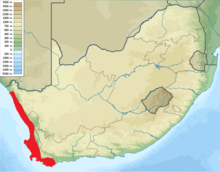| Moegistorhynchus longirostris | |
|---|---|

| |
|
Scientific classification
| |
| Domain: | Eukaryota |
| Kingdom: | Animalia |
| Phylum: | Arthropoda |
| Class: | Insecta |
| Order: | Diptera |
| Family: | Nemestrinidae |
| Genus: | Moegistorhynchus |
| Species: | M. longirostris
|
| Binomial name | |
| Moegistorhynchus longirostris (
Wiedemann, 1819)
| |

| |
Moegistorhynchus longirostris is a keystone species of fly that lives on the west coast of South Africa. [1]
Anatomy
M. longirostris has a very long proboscis that is believed to be the product of an evolutionary arms race between pollinating insects and long-tubed flowers. [1]
Ecology
The species pollinates, partly or exclusively, at least 20 species of Iridaceae (such as Lapeirousia anceps), [2] Geraniaceae, and Orchidaceae. [1]
References
- ^ a b c Barraclough, David; Slotow, Rob (November 2010). "The South African Keystone Pollinator Moegistorhynchus longirostris (Wiedemann, 1819) (Diptera: Nemestrinidae): Notes on Biology, Biogeography and Proboscis Length Variation". African Invertebrates. 51 (2): 397–403. doi: 10.5733/afin.051.0208. ISSN 1681-5556. S2CID 86127943.
- ^ "Lapeirousia anceps". www.biodiversityexplorer.info. Retrieved 2023-07-25.
| Moegistorhynchus longirostris | |
|---|---|

| |
|
Scientific classification
| |
| Domain: | Eukaryota |
| Kingdom: | Animalia |
| Phylum: | Arthropoda |
| Class: | Insecta |
| Order: | Diptera |
| Family: | Nemestrinidae |
| Genus: | Moegistorhynchus |
| Species: | M. longirostris
|
| Binomial name | |
| Moegistorhynchus longirostris (
Wiedemann, 1819)
| |

| |
Moegistorhynchus longirostris is a keystone species of fly that lives on the west coast of South Africa. [1]
Anatomy
M. longirostris has a very long proboscis that is believed to be the product of an evolutionary arms race between pollinating insects and long-tubed flowers. [1]
Ecology
The species pollinates, partly or exclusively, at least 20 species of Iridaceae (such as Lapeirousia anceps), [2] Geraniaceae, and Orchidaceae. [1]
References
- ^ a b c Barraclough, David; Slotow, Rob (November 2010). "The South African Keystone Pollinator Moegistorhynchus longirostris (Wiedemann, 1819) (Diptera: Nemestrinidae): Notes on Biology, Biogeography and Proboscis Length Variation". African Invertebrates. 51 (2): 397–403. doi: 10.5733/afin.051.0208. ISSN 1681-5556. S2CID 86127943.
- ^ "Lapeirousia anceps". www.biodiversityexplorer.info. Retrieved 2023-07-25.